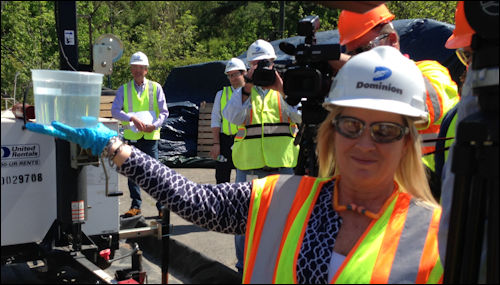
A Dominion employee holds a container of treated coal-ash wastewater at the company’s Bremo facility. The water was treated to be safe for aquatic life, not for people to drink. It would make no sense to do so.
by James A. Bacon
Yeah, I have a problem — a big problem — when people like Marion Kanour, an Episcopal priest from Nelson County and a member of the Knitting Nannas of Virginia, are quoted uncritically in newspaper articles like today’s Richmond Times-Dispatch coverage of an environmental protest.
Referring to treated coal-ash wastewater released into the James River from Dominion Virginia Power’s Bremo Power Station yesterday, Kanour said:
I’m not sure how many parts per million you’re willing to ingest, but I’m not willing to ingest any. I guess it was much less expensive to poison the rest of us.
There are environmentalist professionals who know what they’re talking about, and then there are local activists who don’t. The professionals are careful what they say. The activists spew crazy stuff that clouds the debate. Kanour’s quote is a classic example of crazy stuff.
No one will be “ingesting” wastewater in parts per million or any other detectable level. The discharge will flow into the James River at a maximum rate of 1,500 gallons per minute and mix with a river flow of 5.5 million gallons per minute under normal conditions. The nearest water intake for a municipal treatment facility is 50 miles downstream. Any water taken into the Richmond water treatment plant undergoes an extensive treatment to make it suitable for drinking. A critical step is adding chlorine to kill bacteria. The Bremo wastewater is not treated with chlorine because adding that chemical to the river…. (drum roll)… would be harmful to aquatic organisms.
The kinds of statements Kanour makes have nothing to do with the real debate. The battle line is not over whether to put toxic swill or clean, drinkable water into the river, but over how frequently to test wastewater quality and what protocols to follow to ensure the water meets DEQ standards. The parameters of the dialogue between DEQ, Dominion and environmental groups are extremely narrow. If the Bremo controversy were a football field, the question is whether the football belongs on the 49 yard line or the 47 yard line, not the 10 yard line.
Talk about “poisoning” people with undrinkable water is hysterical nonsense that alarms people unnecessarily and makes it more difficult for the professionals — and by that I include the environmental groups who do know what they’re talking about — to do their jobs.
Update: Bacon eats crow. In the original post, I chastised Marion Kanour for spouting “crazy stuff,” such as saying that heavy metals discharged into the James River would be measured in “parts per million” instead of “parts per billion.” Well, in that instance, I’m the one who spouted crazy stuff, for, in fact, effluent levels are measured in micrograms, which are units equivalent to one-millionth of a liter. So I formally apologize for my rash statement, and I have removed the offending paragraph.
The rest of my criticism stands.
–JAB


